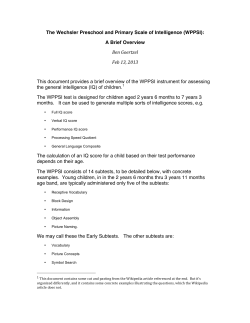
The Wechsler Intelligence Scale for Children — Fourth Edition
The Wechsler Intelligence Scale for Children — Fourth Edition Information for Parents and Teachers The Wechsler Intelligence Scale for Children – Fourth Edition (WISC-IV) is the most widely used intelligence test for assessing children between the ages of 6 to 16 years and 11 months. The WISC-IV provides information about cognitive functioning however there is no one to one correspondence between performance on an intelligence test and performance in school. Other factors for consideration include motivation, life experience, health, emotional state and individual interests/talents. Administering a test such as the WISC-IV allows for the identification of a child’s strengths and weaknesses and can provide a starting point for further investigation (e.g. a low Working Memory Index score may indicate that a more specific test of working memory be administered to investigate the child’s functioning n this area further). It also allows teachers to be aware of the level at which a child is functioning, which will enable the enhancement of their strengths and the implementation of strategies to accommodate/compensate for their weaknesses. Structure of the WISC-IV The WISC-IV provides a Full-Scale IQ to represent a child’s overall cognitive ability. Four additional composite scores can also be derived to represent the child’s functioning in more discrete domains of cognitive functioning: the Verbal Comprehension Index, the Perceptual Reasoning Index, the Working Memory Index and the Processing Speed Index. Each Index is made up of subtests; these are the tasks that the child completes during the test. There are 10 core subtests divided amongst the four Indices which are the standard subtests that most examiners administer. There are also 5 supplementary subtests which provide a broader sampling of cognitive and intellectual functioning and may be substituted for core subtests. Administration Administration time of the WISC-IV can vary from anywhere between 45 and 90 minutes. Ideally the test is administered in one session, however sometimes it is administered over several sessions due to time restrictions or the child showing signs of fatigue. Rapport between the child and examiner is built before the test begins in an attempt to ensure the child feels comfortable and also to ensure the child cooperates with the test. PSYCHOLOGY · SPEECH PATHOLOGY · ASSESSMENT · LOCUM Phone 03 9380 5742 Fax 03 9380 6883 Email info@lewisandlewis.com.au Web www.lewisandlewis.com.au Address PO Box 476 Brunswick VIC 3056 The test is administered in a standardised manner to enhance reliability and maintain consistency (e.g. instructions are read out verbatim from the test manual and the core subtests are administered in the same order). Every psychologist recites the same instructions and administers the core subtests in the same order for each child he/she assesses. Most subtests begin with practice items before moving on to an age specific start point. Starting at a specific point depending on age allows the child to skip questions that may be too easy which reduces time taken to complete the test and also enhances motivation and interest. If a child does not obtain a perfect score on the first two items administered, the examiner administers items in reverse sequence until a perfect score on two items is reached (e.g., if an 8 year old child begins at item 5 and does not obtain a correct score, items 4-1 are administered until he/she receives a perfect score on two items). If a child receives a score of 0 on a specified number of items (the number of items differs for each subtest), he/she has met the discontinuation rule for that subtest and the examiner then moves on to the next subtest. This is so that the child does not become discouraged if he/she provides incorrect answers or failed to respond because the questions/task were too difficult. Most IQ tests such as the WISC-IV cannot be readministered within a one year period. This is because research has suggested that if a test is readministered within two years, practice effect may occur which would inflate the child’s score thus rendering the assessment invalid. Scoring After scoring the subtests, raw scores are derived by summing the number of correct items within each subtest. These raw scores are converted into scaled scores which are comparative within the child’s own age group. Scaled scores allow a child’s abilities to be compared with the typical performance of others that age. The scaled scores for each Index are then converted into IQ scores which can be directly comparable across age groups. The IQ classifications are as follows: Very Superior Superior High Average 130 and above 120-129 110-119 Average 90-109 Borderline 70-79 Low Average 80-89 Extremely Low 69 and Below Administering the test to children with special needs Children with physical, language or sensory limitations are often referred for a cognitive assessment. The examiner must take into account their special needs when administering the assessment (e.g. a child with motor difficulties may be at a disadvantage with subtests that require manual manipulation. In this case the examiner may only choose to administer the subtests that require little manual manipulation or substitute the core subtests with the supplementary subtests). Children with a non-English speaking background or where English is their second language may also be at a disadvantage with the test. In circumstances such as this, an interpreter will be used to translate the test in the child’s preferred language. Most interpreters are very proficient in translating cognitive tests such as the WISC-IV and will translate verbatim what is said by the examiner and the child. PSYCHOLOGY · SPEECH PATHOLOGY · ASSESSMENT · LOCUM Phone 03 9380 5742 Fax 03 9380 6883 Email info@lewisandlewis.com.au Web www.lewisandlewis.com.au Address PO Box 476 Brunswick VIC 3056
© Copyright 2025





















